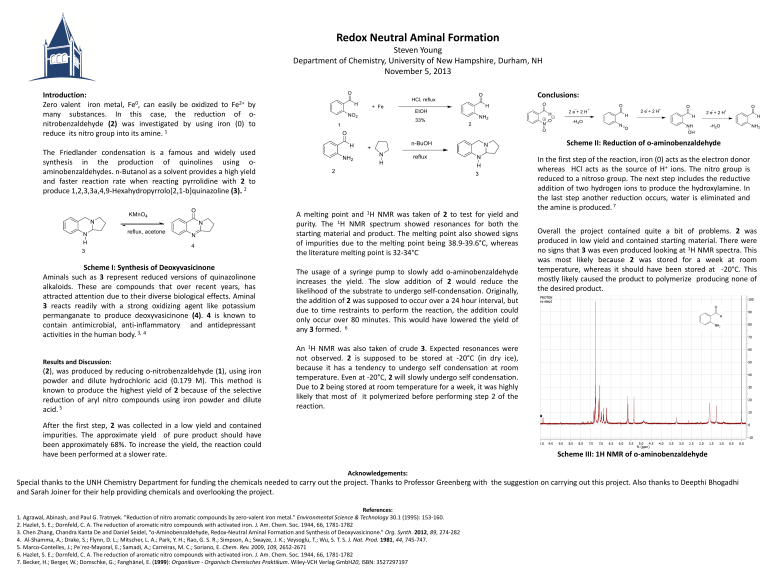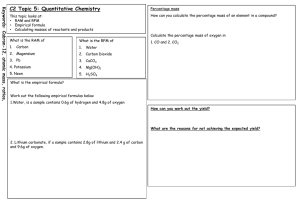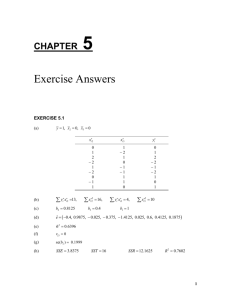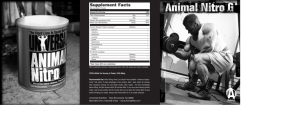Here is the Original File - University of New Hampshire

Redox Neutral Aminal Formation
Steven Young
Department of Chemistry, University of New Hampshire, Durham, NH
November 5, 2013
Introduction:
Zero valent iron metal, Fe 0 , can easily be oxidized to Fe 2+ by many substances.
In this case, the reduction of onitrobenzaldehyde (2) was investigated by using iron (0) to reduce its nitro group into its amine.
1
The Friedlander condensation is a famous and widely used synthesis in the production of quinolines using produce 1,2,3,3a,4,9-Hexahydropyrrolo[2,1-b]quinazoline (3). 2 oaminobenzaldehydes. n-Butanol as a solvent provides a high yield and faster reaction rate when reacting pyrrolidine with 2 to
Conclusions:
Scheme II: Reduction of o-aminobenzaldehyde
In the first step of the reaction, iron (0) acts as the electron donor whereas HCl acts as the source of H + ions. The nitro group is reduced to a nitroso group. The next step includes the reductive addition of two hydrogen ions to produce the hydroxylamine. In the last step another reduction occurs, water is eliminated and the amine is produced.
7
Scheme I: Synthesis of Deoxyvasicinone
Aminals such as 3 represent reduced versions of quinazolinone alkaloids. These are compounds that over recent years, has attracted attention due to their diverse biological effects. Aminal
3 reacts readily with a strong oxidizing agent like potassium
permanganate to produce deoxyvasicinone (4). 4 is known to contain antimicrobial, anti-inflammatory activities in the human body.
3, 4 and antidepressant
A melting point and 1 H NMR was taken of 2 to test for yield and purity. The 1 H NMR spectrum showed resonances for both the starting material and product. The melting point also showed signs of impurities due to the melting point being 38.9-39.6°C, whereas the literature melting point is 32-34°C
The usage of a syringe pump to slowly add o-aminobenzaldehyde increases the yield. The slow addition of 2 would reduce the likelihood of the substrate to undergo self-condensation. Originally, the addition of 2 was supposed to occur over a 24 hour interval, but due to time restraints to perform the reaction, the addition could only occur over 80 minutes. This would have lowered the yield of any 3 formed.
6
An 1 H NMR was also taken of crude 3. Expected resonances were not observed. 2 is supposed to be stored at -20°C (in dry ice), because it has a tendency to undergo self condensation at room temperature. Even at -20°C, 2 will slowly undergo self condensation.
Due to 2 being stored at room temperature for a week, it was highly likely that most of it polymerized before performing step 2 of the reaction.
Overall the project contained quite a bit of problems. 2 was produced in low yield and contained starting material. There were no signs that 3 was even produced looking at 1 H NMR spectra. This was most likely because 2 was stored for a week at room temperature, whereas it should have been stored at -20°C. This mostly likely caused the product to polymerize producing none of the desired product.
Results and Discussion:
(2), was produced by reducing o-nitrobenzaldehyde (1), using iron powder and dilute hydrochloric acid (0.179 M). This method is known to produce the highest yield of 2 because of the selective reduction of aryl nitro compounds using iron powder and dilute acid.
5
After the first step, 2 was collected in a low yield and contained impurities. The approximate yield of pure product should have been approximately 68%. To increase the yield, the reaction could have been performed at a slower rate.
Scheme III: 1H NMR of o-aminobenzaldehyde
Acknowledgements:
Special thanks to the UNH Chemistry Department for funding the chemicals needed to carry out the project. Thanks to Professor Greenberg with the suggestion on carrying out this project. Also thanks to Deepthi Bhogadhi and Sarah Joiner for their help providing chemicals and overlooking the project.
References:
1. Agrawal, Abinash, and Paul G. Tratnyek. "Reduction of nitro aromatic compounds by zero-valent iron metal." Environmental Science & Technology 30.1 (1995): 153-160.
2. Hazlet, S. E.; Dornfeld, C. A. The reduction of aromatic nitro compounds with activated iron. J. Am. Chem. Soc. 1944, 66, 1781-1782
3. Chen Zhang, Chandra Kanta De and Daniel Seidel, “o-Aminobenzaldehyde, Redox-Neutral Aminal Formation and Synthesis of Deoxyvasicinone.” Org. Synth. 2012, 89, 274-282
4. Al-Shamma, A.; Drake, S.; Flynn, D. L.; Mitscher, L. A.; Park, Y. H.; Rao, G. S. R.; Simpson, A.; Swayze, J. K.; Veysoglu, T.; Wu, S. T. S. J. Nat. Prod. 1981, 44, 745-747.
5. Marco-Contelles, J.; Pe´rez-Mayoral, E.; Samadi, A.; Carreiras, M. C.; Soriano, E. Chem. Rev. 2009, 109, 2652-2671
6. Hazlet, S. E.; Dornfeld, C. A. The reduction of aromatic nitro compounds with activated iron. J. Am. Chem. Soc. 1944, 66, 1781-1782
7. Becker, H.; Berger, W.; Domschke, G.; Fanghänel, E. (1999): Organikum - Organisch Chemisches Praktikum. Wiley-VCH Verlag GmbH20, ISBN: 3527297197











